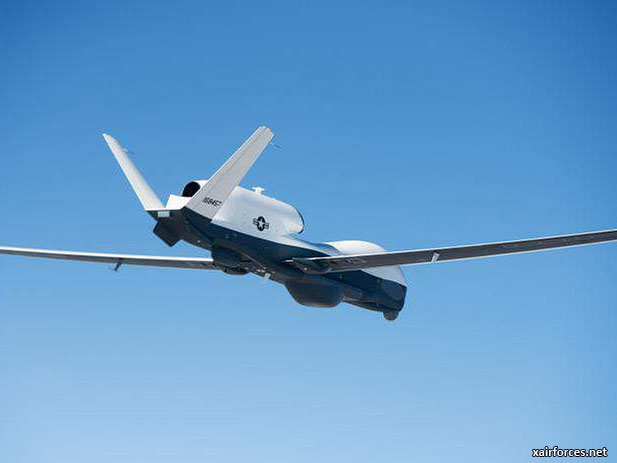
US Navy Unmanned Air Takes Off

Triton, Integrator and X-47B UAVs Hit Milestones in May. May has been celebrated in song and words as merry, charming, even lusty. Based on the just-concluded 2013 edition, the month might also be seen as uplifting, at least in an unmanned aviation sort of way, with a number of significant events taking place across US Navy unmanned aircraft programs big and small.
The biggest splash took place May 14, when the X-47B jet made its first launch at sea from an aircraft carrier.
Three days later, the aircraft returned to the George H.W. Bush off the Virginia coast for a series of touch-and-go landing approaches — preludes to an actual arrested landing that should take place within weeks.
On May 22, the first MQ-4C Triton — formerly known as the Broad Area Maritime Surveillance (BAMS) system — took to the air over southern California, marking the first flight of the Navy’s version of the Global Hawk large, high-altitude UAV.
Tests continued at California’s China Lake Naval Weapons Center, where the MQ-8B Fire Scout is firing laser-guided rockets using the Advanced Precision Kill Weapons System (APKWS), giving the little unmanned helicopter a weapon already in use on UH-1Y and AH-1Z manned helos.
On May 15, the Navy announced that a new UAV, the RQ-21A Integrator, had received approval to enter low-rate initial production.
Built by Boeing’s Insitu subsidiary — the company that also makes the widely-used ScanEagle — the RQ-21A is aimed at giving special operations forces a tactical ISR capability.
In the Arabian Gulf, the now-familiar ScanEagle provided ship-based ISR throughout the International Mine Countermeasures Exercise 2013.
The ScanEagle system, which is not a Navy program of record and has no designation, is generally operated in the field by Insitu contractors.
And a small but effective demonstration program, the K-MAX battlefield cargo helicopter, was extended for a year to support Marines in Afghanistan.
All told, the events mark the steady evolution of unmanned air as the day comes when UAVs will become a routine element in naval operations.
Together, the events are “yet another shot in the arm of success as the Department of the Navy methodically and logically integrates unmanned systems to our warfighter,” Rear Adm. Mat Winter, program executive officer for Unmanned Aviation and Strike Weapons, told reporters during a May 23 press call after the Triton’s flight.
“The aircraft provide the spectrum of ISR and warfighting capability,” he added. “And we also see that in Fire Scout, ScanEagle, UCAS and the kickoff of UCLASS.”
■ The Carrier Jet. Unquestionably the event with the biggest significance was the first catapult launch of the Northrop Grumman X-47B Unmanned Combat Air System Demonstrator (UCAS-D), an experimental aircraft designed to prove out technologies and procedures to operate an unmanned jet from a carrier.
The two-plane program will continue with flight tests through the year, shifting from ground-based operations at the Navy’s aviation test base at Patuxent River, Md., to at-sea operations. In particular, the Navy is working out flight deck handling procedures and launch and recovery operations, all aimed at the transition next year to the Unmanned Carrier Launched Airborne Surveillance and Strike (UCLASS) program, the effort to develop an operational, unmanned carrier-based jet with combat capability. A new competition will be held for that aircraft, which may or may not be based on Northrop’s X-47B design.
■ The Long-range Surveillance Aircraft. The May 22 first flight of the Northrop Grumman MQ-4C marked a major milestone, presaging the future pairing of the unmanned Triton with the Boeing P-8A Poseidon maritime patrol aircraft.
Engineers intend to fly the MQ-4C about every 10 days, and the second flight is expected in early June. Two systems development and demonstration aircraft have been delivered, with three more systems development and test article aircraft in production, intended to carry out the type’s operational evaluation tests. The first Triton system is to become operational in 2016 with 5th Fleet in the Middle East. The Navy intends to buy a total of 65 aircraft, although procurement is spread out through 2027.
■ The New UAV. The RQ-21A is about twice the size of the ScanEagle but shares a similar catapult launch and skyhook recovery system. The aircraft has about a 25-pound payload capacity, and is designed to transition operations from ships to Marine forces ashore. Successful flight tests of the Small Tactical Unmanned Aircraft System (STUAS) were carried out in February aboard the amphibious ship Mesa Verde. The Navy plans to buy 36 systems, each with five aircraft and a ground control station.
■ The Cargo Drone. The Lockheed Martin-Kaman K-MAX demonstration program has been operated in Afghanistan by Marine Unmanned Aerial Vehicle Squadron 2. Two of the little twin-rotor helicopters have been flying in-country since November 2011, carrying cargo in sling loads. Although the K-MAX is not a program of record, Marine and Navy officials continue to evaluate the program’s performance.
Source: By CHRISTOPHER P. CAVAS - WASHINGTON — defensenews.com News - 4 May 2013
Photo: The U.S. Navy first MQ-4C Triton flies over southern California during its maiden flight May 22. (Bob Brown/Northrop Grumman)
(4.05.2013)
|